 |
||
|
Jupiter's
northern auroral oval.
|
||
| JUPITER'S MAGNETIC FIELD | ||
| Of all the planets Jupiter has the largest and most intense magnetic field. The strength of the Jovian magnetic field is about 19,000 times greater than Earth's. Jupiter's rapid spin (about 10 hours) induces a charge in the electric currents present in the liquid metallic hydrogen layer which makes up most of the planet. Jupiter's magnetic field is ten times as strong as the Earth's and far more complex. | ||
| The presence of a magnetic field about Jupiter first became apparent in the 1950s when emissions were detected using radio telescopes. These were inferred to result from the interaction of high energy particles with a magnetic field around Jupiter. Jupiter is a strong radio transmitter, and at some wavelengths it outshines the Sun. That is, if your eyes could see those wavelengths, you would see your way around by Jupiter-radio, and not by sun-light. Pioneer, followed by the Voyager spacecraft, were used to study the magnetic field in detail. | ||
| Origin | ||
| Jupiter's rapid spin causes the metallic hydrogen within to flow. This generates electric currents in the same way as does a dynamo, converting mechanical energy to electrical energy. The electric current in turn produces a field. The field opposes the force which has set it up, which stops it from increasing in strength perpetually. | ||
| Structure | ||
| The field is inclined, like Earth's, to the planet's axis of rotation by about 11o. The field at about 212,000 kilometres from Jupiter is dipolar like Earth's. This means that it behaves as if a large and powerful magnet runs through the middle of the planet. The polarity of Jupiter's magnet, the alignment of the north and south magnetic poles, is at the moment opposite to Earth's. If it were used on Jupiter, a compass from Earth would point south. It is possible that the field changes polarity like Earth's, but it is not known how often this might occur. | ||
| Close to Jupiter, the field is mainly dipolar but has a more complex configuration, possibly owing to the existence of an exotic flow pattern in the liquid layers. Quadrupole (four pole) and octopole (eight pole) fields are superimposed upon the main dipolar field. The entire magnetic field, or magnetosphere, is enclosed by an envelope called the magnetosheath. Charged particles from the Sun are deflected by the magnetic field and a bow shock is generated. It is like the bow wave formed at the front of a moving ship. As the level of solar wind fluctuates, the size of Jupiter's magnetosheath varies accordingly. | ||
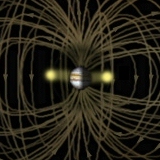 The powerful magnetosphere of Jupiter. |
||
| The outmost limit of the magnetosheath on the side facing the Sun (the front of the bow wave) is called the magnetopause and is about 700 million kilometres from Jupiter. | ||
| The highest temperatures recorded in the Solar System are found just within the magnetopause. Voyager passed though a zone where the temperature was between 300 and 400 million K. It gets so hot because solar wind particles are slowed from 1.5 million kilometres per hour to just 0.4 million kilometres per hour when they reach the magnetosphere. The rapid deceleration makes them heat up. | ||
| The trailing edge of the magnetic field is called the magnetotail and extends beyond the orbit of Saturn. Beyond 1.5 million kilometres from Jupiter, the field creates a large disc, level with Jupiter's equator. This disc is formed of low energy plasma. Because it is aligned with the magnetic field and not Jupiter's physical equator, it appears to wobble as it spins. | ||
| The inner torus | ||
| Within the magnetic field is a thick ring or torus-shaped zone. It contains the equivalent of Earth's Van Allen belts. The field here traps charged particles - electrons, protons, and some metallic ions. In this region the particles which form the "plasma" are highly energetic and can easily damage a spacecraft's electronics if they are not protected. | ||
| The radiation belt is compressed by rapid rotation and magnetic forces. Jupiter's six innermost moons are influenced by the magnetic field and also interact with the plasma. The moons are the source of charged particles. The metallic ions are thought to have been erupted by Io's volcanoes, and calculations suggest that Io dumps about a ton per second into the torus. | ||
 The inner structure of Jupiter's magnetosphere. |
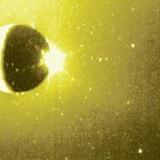 Io's volcanoes are a source of charged particles - here Galileo has imaged Io's sodium cloud. |
|
| Aurorae | ||
| Planetary auroral activity is similar to the behaviour of gas in a fluorescent or neon tube when an electrical current is passed through it. Auroral displays, similar to the northern lights on Earth, have been observed in Jupiter's polar regions. At Jupiter, however, the aurorae are over a thousand times stronger than those observed on Earth. There is also more than one mechanism involved at Jupiter. On Earth, auroral activity can be attributed to incoming solar wind interacting with Earth's magnetic field. Although this mechanism plays a role in the Jovian case, matters are further complicated by Jupiter's moon Io. | ||
| Material from Io travels along the lines of Jupiter's magnetic field arriving at the poles where it interferes with the atmosphere. The particles travelling from Io form what is called a "flux tube". The material from Io's flux tube also causes electrical storms, a few of which were captured in Voyager images. The flux tube between Io and Jupiter is a bridge between two completely different worlds, and along this tube can flow a huge amount of power, in the region of 3 million amperes. Where this flux meets Jupiter's atmosphere, small additional auroral spots are generated. The bridge between Io and Jupiter was recognised as a result of detections of radio-bursts from Jupiter. The bursts of energy showed a relationship with Io's orbital position. | ||
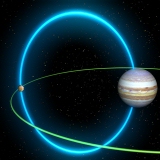 Material travels from Io to arrive at Jupiter's polar regions. |
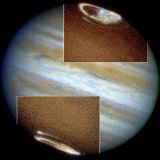 Jupiter's auroral displays superimposed on an optical view of the planet. |
|
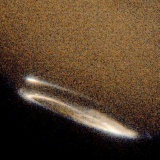 The aurora over Jupiter's south pole, as seen by the Hubble Space Telescope. |
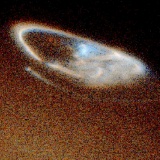 Hubble Space Telescope false-colour image of Jupiter's northern auroral display. |
|
| The overall shape of the aurorae on Jupiter change over the course of a Jovian day (about 10 hours), such changes possibly caused by compression of the magnetic field over the sunlit part of Jupiter. There are also more rapid small-scale changes. | ||
| If you were able to visit Jupiter's cloudtops, the aurora above you would stretch from horizon to horizon. As Jupiter rotates faster than Io orbits, you would see the aurora travel across the sky at 5 kilometres per second, or 18,000 kilometres per hour. | ||
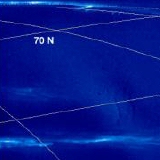 Galileo has provided scientists with detailed views of Jupiter's aurorae. |
 Image of the northern aurora over Jupiter's nightside. |
|
 The southernmost part of the northern auroral oval on Jupiter's nightside, as seen by Galileo. |
 Small scale structure in the aurora is revealed in this false-colour composite of Galileo images. |
|
|
|
||